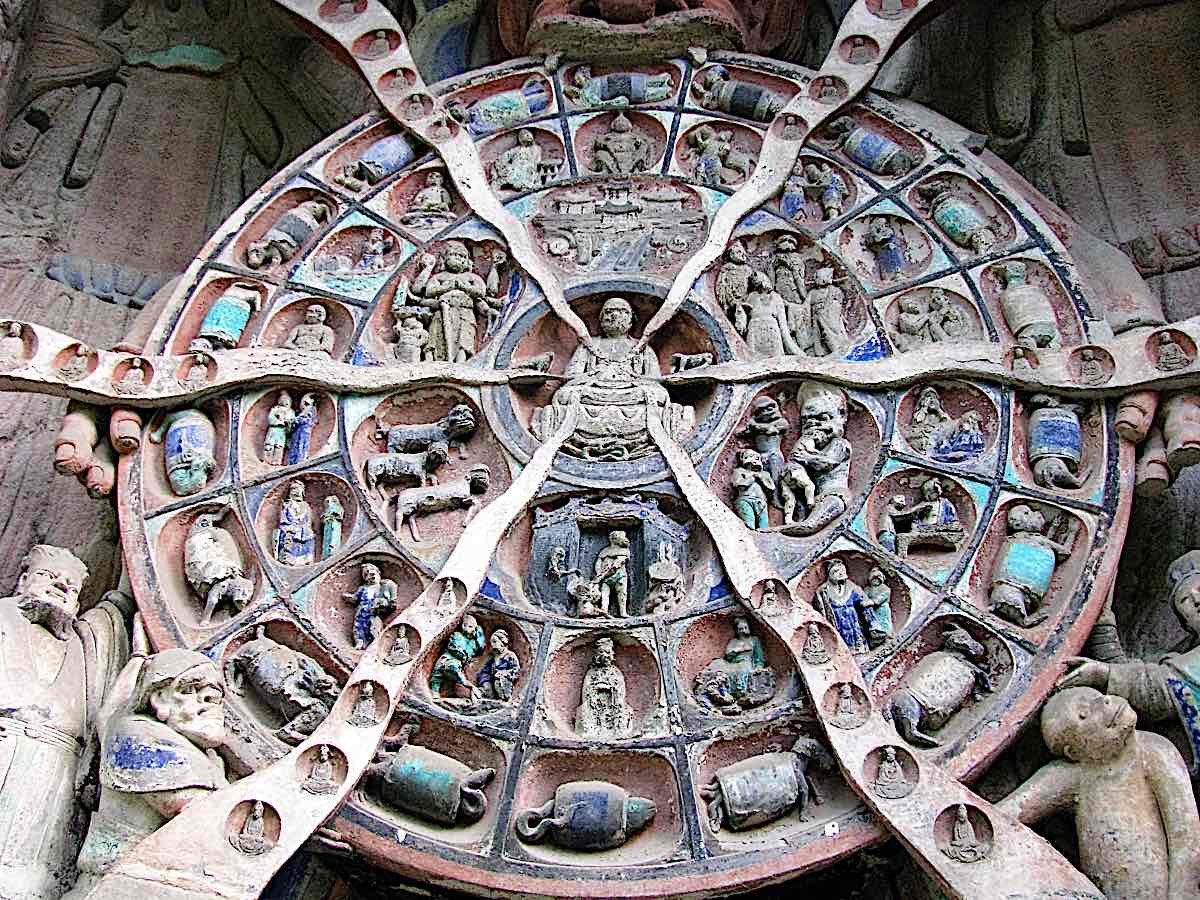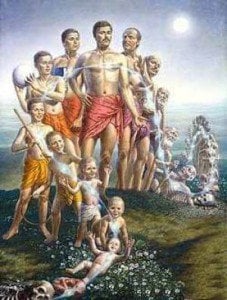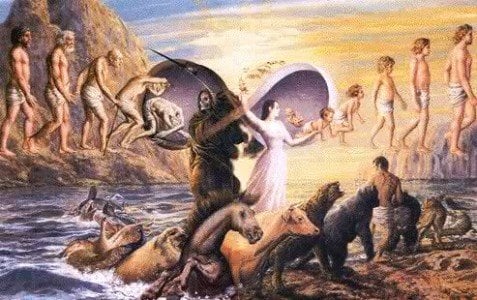The Science of Reincarnation and Rebirth? The research into verified past lives claims
Have you ever wondered about what happens after we die? Some believe that our souls reincarnate — or are reborn — into other beings or come back to Earth in another form. Others think that we simply disappear and...

Have you ever wondered about what happens after we die?
Some believe that our souls reincarnate — or are reborn — into other beings or come back to Earth in another form. Others think that we simply disappear and cease to exist. Is this just wishful thinking? Buddha taught Karma and Dependent Arising and rebirth, but is this just a matter of faith?
What does science have to say about this phenomenon?
 Buddhist wheel of Life. Wiki Commons.
Buddhist wheel of Life. Wiki Commons.
Are we really reincarnated into other lives? Are there any verified cases of past lives? And if so, what can we learn from them?
Don’t miss the excellent documentary on the work of Dr. Stevenson embedded below. See our full section of features on Rebirth and Reincarnation>>What are reincarnation and rebirth?
Reincarnation is the belief that after we die, our souls are reborn into other bodies.
In this sense, the soul could be considered an immortal entity that carries the memories and experiences of our past lives and brings them into our current lives.

The concept of rebirth is similar to reincarnation, but with one key difference. In rebirth, it is not the soul that is reborn into a new body but rather the consciousness.
So, while in reincarnation, the soul carries the memories of its past lives, in rebirth, those memories are not carried over into the new life.
Another difference is that through rebirth, a person can be born into any life form, not just human.
 Rebirth is a central concept in Buddhism.
Rebirth is a central concept in Buddhism.
These beliefs are rooted in ancient philosophies and spiritual paths such as Hinduism, Buddhism, and Jainism, and many other faiths. Hinduism and Jainism believe in reincarnation — that is, the soul is reborn into another body after death, while Buddhism believes in the rebirth of the consciousness. (A subtle distinction.)
In Buddhist teachings, rebirth occurs endlessly as part of a cycle of birth, death, and rebirth. Our rebirth is conditioned by the karma or actions of our previous life — for instance “unresolved attachments” conditioned into our consciousness. Our goal, according to Buddhism, is to break this cycle of conditioning and achieve nirvana, or liberation from suffering.
 Rebirth as a belief causes some difficulty for students new to Buddhism and Agnostic Buddhists.
Rebirth as a belief causes some difficulty for students new to Buddhism and Agnostic Buddhists.
But are there any scientific theories that could explain these phenomena, or is it all just a matter of faith?
The science of reincarnation and rebirth
There are some difficulties in researching reincarnation and rebirth scientifically.
The scientific method is ideal for phenomena that are observable and testable. But reincarnation and rebirth happen after death, so it’s not possible to observe them directly. Instead, the evidence for these hypotheses must be indirect.
This means that scientists have to rely on people’s memories of their past lives and try to verify them.
A documentary on Dr. Stevenson’s work:
This can be challenging, as our current beliefs and expectations can influence memories and may not be accurate. That’s one of the reasons why past life regressions, where people are hypnotized and believe they remember their past lives, are so controversial and not generally considered solid scientific evidence of reincarnation or rebirth.
However, cases of past life memories often come from very young children who have not yet developed their own beliefs or had extensive external influences and life experiences to distort their memories.
There have been many cases of young children remembering details from a past life that they couldn’t possibly know about otherwise. These cases are often verified through independent corroboration of the details that the child remembers.
And strikingly, in some cases, the children with memories of past lives also have birthmarks or birth defects that correspond to wounds or injuries from which the person they remember died in their previous life.
According to the scientific method, as long as there is one verified case of reincarnation or rebirth, then it cannot be said that there is no such thing as reincarnation or rebirth.
While scientists cannot say with 100% certainty what happens after we die, by now, there is a significant body of evidence that suggests that reincarnation and rebirth are real phenomena.
And, as with any scientific theory, the more evidence that supports it, the more probable it becomes.
Pioneering the research into past lives: Dr. Ian Stevenson
Despite the difficulties in researching reincarnation and rebirth scientifically, scientists have been fascinated with the idea for centuries.
One of the more recent pioneers in this field was Dr. Ian Stevenson, a Canadian psychiatrist who spent his career investigating cases of past life memories.
Dr. Stevenson developed an interest in reincarnation early in his career after observing that different people would develop different diseases when faced with stress. He felt that this was an indication that illnesses were not just caused by physical, genetic, or environmental factors but that there might be some form of memory transfer that happened from one life to the next. [1]
Stevenson developed his interest in reincarnation further during his studies and career and devoted his life to investigating cases of past life memories.
In 1957 he was appointed Chair of Psychiatry at the University of Virginia, which allowed him to dig deeper into his interest in past lives and the paranormal. His research areas were not always popular, and finding funding was challenging.
Fortunately for Stevenson, he found a benefactor in Chester Carlson. The inventor of the xerography, the process we now know as photocopying, was introduced to Stevenson’s work by his spiritualist wife. Upon his death, he left a generous donation to the University of Virginia, earmarked explicitly for Stevenson’s research.
Carlson’s donation of one million dollars allowed Stevenson to devote his life to the full-time study of past life memories.
Over the next four decades, Stevenson and his team would investigate over 3,000 cases of past life memories from all over the world.
Some cases were much more substantial than others, but Stevenson could often identify a figure from a child’s statement based solely on the information given. The level of evidence included in many cases was difficult to explain by rational means, partly thanks to Stevenson’s efforts to disconfirm the paranormal account.
By ensuring that he had eliminated all other possible explanations for the memories, Stevenson could build a strong case that past lives are a reality that would be difficult to refute by skeptics. [2]
The Division of Perceptual Studies
The Division of Perceptual Studies (DOPS) is a research unit within the Department of Psychiatry and Neurobehavioral Sciences at the University of Virginia.
It was founded in 1967 to continue Dr. Stevenson’s studies and investigate various paranormal phenomena, including past life memories, out-of-body experiences, and near-death experiences. [3]
Despite the growing widespread interest in these topics, research into the paranormal faces challenges due to a lack of funding and interest from the scientific community. This is why units like DOPS are so important, as they provide a space for this type of research to take place.
Other notable research units investigating paranormal phenomena include the University of Amsterdam, Lund University in Sweden, the University of Arizona, the University of Nevada in Las Vegas, and the University of Edinburgh.
The main area of study for the DOPS still remains reincarnation, and it is now one of the world’s leading centers for research into past lives.
They’ve published many books on its findings and research papers published in peer-reviewed journals and presented at academic conferences.
Since 2014, Professor Jim B. Tucker has been the Director of the DOPS and has continued the work started by Stevenson all those years ago.
Jim B. Tucker’s research into past lives
In the late 1990s, Tucker read an article in the Charlottesville Daily Progress about Stevenson’s office receiving a grant to study near-death experiences. Inspired by what he had been reading, Tucker decided to pursue his own research on reincarnation, curious to see if it was possible to study life after death through the scientific method.
After a few years of volunteering in Stevenson’s department, he became a permanent researcher in the office. His duties included overseeing the electronic coding of Stevenson’s reincarnation cases.
Tucker published two books based on his research; “Life Before Life” in 2005, which presents the research that takes place at the DOPS, and “Return to Life,” which looks at American cases of children’s memories of past lives.
Tucker explains that the strength of each potential case he encounters varies. For instance, after studying certain cases, it becomes clear that a child’s statements can be traced to a family who desperately misses a deceased loved one and not from a past life, so the case is dismissed.
In many cases, however, the only logical explanation that remains is that the child simply recalls moments from a past life.
Study cases of reincarnation
One of these cases was four-year-old Ryan Hammons. This Oklahoma native dreamed of directing movies as many children do. But what was special about Ryan was seemed to have memories from someone else’s life as an actor in Hollywood. He remembered his friends, his children, his home, and even about past jobs he held.
Ryan’s story is just one example of a case of young children who remember details from a past life. [4]
In another well-known case, Stevenson encountered a toddler from Sri Lanka who had unexplained memories of Kataragama, a town unknown to her family. She told her mother that she had drowned there in a previous life and details about her family, their house, and surrounding neighbors. Stevenson’s research team later verified all this information, and it was surprisingly accurate.
The girl made 30 specific, verifiable statements that the research team could check. Of those 30 statements, 27 were correct, and the three incorrect ones were not far from the truth. For example, she named the dead girl’s father “Herath” when, in reality, that was her cousin’s name.
The evidence, in this case, was overwhelming, and it could not be dismissed as a coincidence. The level of details given and the fact that the two families had never met and did not have any friends or relatives in common left little room for doubt that this was a confirmed case of past life memories.
These are just a couple of Stevenson’s over 3,000 cases. Let’s look at the common trends and statistics from these studies to understand better what the DOPS has uncovered about life after death. [2]
The numbers behind past live research
When looking at the general data from Tucker’s research, here are some facts and figures that stand out: [4]
Most children with stories of reincarnation are between 2 and 6 years old.The median age of the previous person at the time of death is 28 The median time between the previous person’s death and the child’s birth is about 16 months. 90% of the children studied are of the same sex as the person they claim to be in their past life. 20% of the children have memories of the time between the death of their past life self and their current birth, although there are no consistent details about what happens during this time. Some children alleged to be in “God’s house,” and others claimed they were simply waiting near the place where they died. 60% of the children who remember a past life are male. In approximately 70% of the cases, the child has memories of a previous life that ended in unnatural or violent causes. Roughly 70% of the cases that reported violent deaths were of males (a similar proportion to that of violent deaths in the general population).In terms of the children, the research shows that they don’t appear to be dissociating from painful family situations or have any reason to be looking for attention when they talk about their memories. They generally have an above-average IQ and don’t show signs of mental or emotional distress.
Regarding age, Tucker’s observation is that the memories tend to fade as the child gets older, generally around six years old. This could be because, at this age, their brains enter a new phase of development.
One common trend they observed is that more cases of children who remember past lives are reported in cultures where belief in reincarnation is prevalent.
This could be due to several factors, including the fact that people in these cultures are more likely to believe the child’s stories, as they form a part of their belief system and are more likely to investigate them.
By contrast, in western cultures, where belief in reincarnation is not as common, these stories are often dismissed as the child’s overactive imagination or vivid dreams and are not taken seriously.
Another significant observation that adds further physical evidence to the study of reincarnation is that nearly 20% of the children studied show birthmarks that look like scars or even birth deformities that closely match injuries the previous person had sustained before their death.
The physical marks of a past life
In 1997, Dr. Stevenson published a two-volume work on his studies called “Reincarnation and Biology,” documenting 225 cases of children with memories of past lives that were accompanied by physical evidence. [2]
In this work, he looks at the children’s birthmarks and deformities and compares them to documentation about the dead person’s life, such as autopsy records or photographs.
The unusual birthmarks took the shape of scar-like markings, such as port-wine stains, or strange-looking moles in areas where moles don’t tend to grow, such as the soles of the feet. And among the congenital disabilities, he found missing digits, limbs that were shorter than average, or other sorts of malformations.
In all of these cases, the physical marks corresponded to injuries that the dead person sustained during their lifetime, usually close to or at the time of death.
One of the most famous cases documented by Dr. Stevenson was a young boy in India who had past life memories of another boy who’d lost the fingers of his right hand in an accident with a chopping machine. The boy’s birth defect, known as “unilateral brachydactyly, consisted of having boneless stubs instead of fingers on his right hand only and was so rare that Stevenson couldn’t find any other documented case of it.
The book also documents the case of a Thai boy who had birthmarks on the back of the head and at the front, similar to the entry and exit wounds that a gunshot would make. Sure enough, the boy’s memories corresponded to a man who was killed when he was shot in the head with a rifle.
These are just some examples of the physical evidence that Stevenson has found in his years of study, which adds further credibility to the scientific research that points to reincarnation being a real phenomenon.
Scientific explanations for past life memories
When reviewing Jim Tucker’s first book, Michael Levin, Director of the Center for Regenerative and Developmental Biology at Tufts University, called the book a “first-rate piece of research” and talked about the difficulties in proving or debunking Tucker’s research. [4]
Levin pointed out that our current methods and concepts in science are not adequate to handle this data, and so they cannot deal with the possibility of reincarnation.
That’s why current scientific research models are not able to provide a definitive answer as to whether reincarnation actually takes place or not.
However, Tucker himself, in his book “Return to Life,” points to the theories of quantum mechanics. This science explains the behavior of particles at the atomic and subatomic levels, which could shed some light on how past life memories could be transmitted from one person to another.
Quantum physics and reincarnation
Quantum physics is not an idea that is simple to grasp. Even some of the world’s most brilliant scientists have trouble wrapping their heads around it.
But the basic idea is that at its smallest level, the universe is not made up of things but instead of energy that is constantly in motion. This energy always interacts and affects other energy, even if those things are not close to each other.
Tucker explains that according to quantum physics, our physical world could even grow out of our consciousness.
Take the experiment of the two slits. In this experiment, particles of light (photons) are fired at a screen with two slits in it. On the other side of the screen is a detector. You would expect the photons to go straight through both slits and hit the sensor. But what actually happens when there is an observer is that the photons go through just one slit.
The photons somehow know that there is an observer, and they change their behavior.
Now, imagine if human beings are made up of this same kind of energy. If we are, it stands to reason that our consciousness could also affect things, even when we’re not physically present.
And if our consciousness can affect things, then it’s possible that our memories and experiences from past lives could be passed on to other people, even if we’re not physically close to them.
Max Planck, the Nobel Prize-winning quantum physicist who first proposed the theory of quantum mechanics, also believed that consciousness was a fundamental part of the universe and affects or even creates the physical world.
If this is true, then there’s no reason to think that consciousness requires a brain and a physical body to exist.
And as Tucker points out, this means there’s no reason to think that consciousness dies when the physical body does. And that opens the door to the possibility that consciousness could reincarnate into another life after the physical body dies.
Of course, all of this is just theory at this point.
The exact mechanisms by which past life memories could be transmitted from one person to another are still very much a mystery. And even though we have some positive evidence for reincarnation, we do not have the research models that would be able to prove or disprove it definitively.
But it seems clear that future advances in quantum physics could hold the key to understanding how reincarnation might work.
Why doesn’t everyone have past life memories?
One of the questions that come to mind when reading about Stevenson and Tucker’s studies on reincarnation is that if human consciousness can survive death and be reborn into another life, as quantum physics seems to show, then why isn’t there more evidence of it?
Stevenson believed that reincarnation might be common, even though most children have no recollection of their previous existence or any memories from that time.
Even in a country like India, where most of the population believes in reincarnation and parents would likely encourage their children to talk about any memories they may have of a previous life, Stevenson found that only one in 500 children showed evidence of past life memories. [2]
So why do so few people seem to remember their past lives?
Stevenson offers some insight from his lens as an expert on psychosomatic medicine. He had always been fascinated with the link between mind and body and how our emotions and experiences can affect our physical health.
With this perspective, he suspected that the strength of emotions around the time of death might play a role in whether or not someone remembers their past life.
If death is traumatic, it likely leaves an emotional imprint, and it may be more difficult for the consciousness to move on.
This would explain why most of the children in his case studies who remembered their past lives had died violent deaths.
He also observed that the children often had fears related to their past life experiences, which would make sense if they were reliving trauma from another existence. For example, if a child had drowned in a past life, they would be intensely afraid of water in this life. If they were killed with a knife, they might have a phobia of sharp objects.
He even recorded three cases where young children reacted violently when they saw their supposed murderer from a previous life.
All this would suggest that the memories of our past lives are more likely to be retained if the death is sudden and violent.
Another interesting observation from Stevenson’s studies is that reincarnation does not seem to be immediate, as some religious traditions suggest. In almost all the cases he studied, there was a few years gap between the death of the previous life and the birth of the new one.
And it’s also worth noting that while some religious traditions suggest that we are reborn into the same family or social class, Stevenson found this was not always the case. In some of his studies, the children were born into a completely different social class than their previous life.
The skeptics
Many challenge the idea of reincarnation, even in the face of Stevenson and Tucker’s compelling evidence. Some argue that this methodology is flawed and that past lives cannot be studied scientifically. Others say that these cases could be easily explained by false memories or the power of suggestion. After all, if a child is told repeatedly that they are the reincarnation of a particular person, they may eventually come to believe it, even if it’s not true. And many challenge the idea of reincarnation simply because it goes against their own religious beliefs don’t allow for it.
Tucker himself was raised a Southern Baptist, so to be skeptical of reincarnation. That is why his research takes great care to rule out other possible explanations for the memories that his subjects recount.
The motive of financial gain doesn’t seem to be a factor in these cases, as these claims don’t bring the children or their families any fame and glory. Indeed, many of the families he has studied worry that they will be ridiculed if they speak publicly about their child’s memories.
This leaves the explanation that it all boils down to children’s overactive imaginations. But as Tucker points out, the fact that these memories are so specific, with details that can often be traced back to a particular person and verified by different sources, makes it hard to dismiss them as mere fantasy.
As he states, “it defies logic that it would just be a coincidence.”
The way we think of life after death
Just because some experiences are beyond our current scientific capacity to explain, that doesn’t mean they’re not real. And in the case of reincarnation and past lives, thanks to the research by Stevenson, Tucker, and others, we now have an overwhelming body of evidence to suggest that it is very much a real phenomenon.
Of course, despite the science, the way we think about life after death will always have some element of personal belief.
The job of researchers is not to give our lives meaning or to help us understand our exact place in the world. Their job, instead, is to gather all the data available, investigate it as best they can, rule out all other possible explanations, and present their findings to the world. It’s then up to us to decide what we make of it all.
And for now, the evidence suggests that reincarnation is either very likely to be real, or, at least difficult to dismiss.
Sources
[1] : https://web.archive.org/web/20110720110857/http://www.medicine.virginia.edu/clinical/departments/psychiatry/sections/cspp/dops/publicationslinks/some-of-my-journeys-in-medicine.pdf
[2]: https://blogs.scientificamerican.com/bering-in-mind/ian-stevensone28099s-case-for-the-afterlife-are-we-e28098skepticse28099-really-just-cynics/
[3] https://med.virginia.edu/perceptual-studies/who-we-are/history-of-dops/
[4]: https://uvamagazine.org/articles/the_science_of_reincarnation

 Tekef
Tekef 































